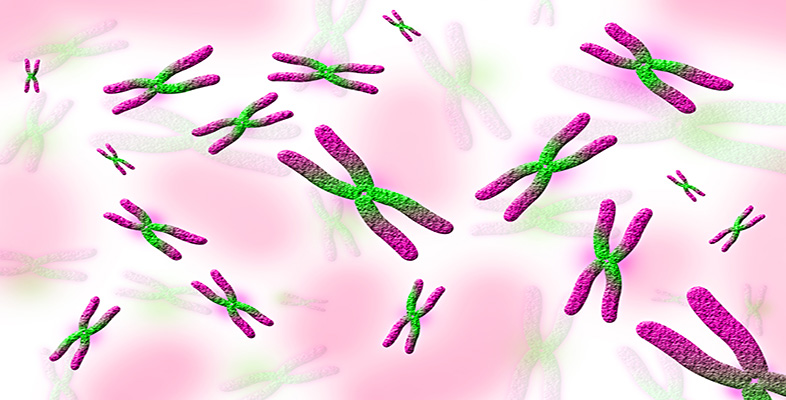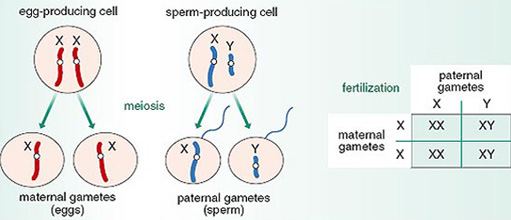1.2.4 Fertilization
Now that we have considered the production of gamete cells, including the process of meiosis, we can examine the next stage of reproduction, the process of fertilization, which occurs inside the female's reproductive tract. As fertilization occurs, the successful sperm stops swimming and a change takes place in the egg cell membrane, which prevents any other sperm from fusing with it. The nucleus of the sperm cell is injected into the cytoplasm of the egg cell. The chromosomes of the fertilized egg thus consist of one set from the egg and one set from the sperm.
The following video clip shows the process of fertilization in more detail.
We have seen that fertilization restores the number of chromosomes to 46 (Figure 4.1)
Why is meiosis such an important feature of reproduction?
If the chromosome number were not halved in the gametes prior to fertilization, the fertilized egg would contain 92 chromosomes, twice the normal number in the parents’ cells.
The fertilized egg grows and develops into an embryo by repeated mitotic divisions. The embryo in turn grows and develops into a fetus, baby, child and finally an adult. The life cycle shown in Figure 4.1 depicts all of the stages that a human must go through from conception through birth to reach adulthood.
One consequence of fertilization can be examined by following the behaviour of the sex chromosomes. We can do this by returning to Figure 4.1, the top part of which we considered earlier. Figure 4.2 is a mating diagram, which shows the parents’ gamete-producing cells, the gametes and the possible combinations of sex chromosomes at fertilization. An individual with a Y chromosome will develop into a male.
From Figure 4.2, what is the expected ratio of female offspring to male offspring?
Half of the sperm contain an X chromosome and every egg also contains one. Therefore, half of the fertilized eggs will be XX, and half will be XY, so the ratio of female to male offspring is 1 : 1.
The ratio of females to the total number of offspring is 1 : 2. Thus, for any fertilization, the chance of producing a girl is 1 in 2, and the chance of producing a boy is the same, 1 in 2. The process of meiosis, which governs the separation, or segregation, of X and Y chromosomes during gamete formation, not only accounts for the occurrence of XX (female) and XY (male) individuals, but is also responsible for the production of the two sexes in the ratio of approximately 1 : 1 in any population.
Figure 4.3 represents a different way of showing the same information in Figure 4.2. Either way of presenting the details of a mating can be used, and when producing your own mating diagrams you can choose whichever is easier for you. In Figure 4.3, the fertilizations between the various combinations of gametes are shown in boxes. Along the top you can see the two types of gamete, X and Y, produced by a male; down the left-hand side you can see the two gametes produced by a female. Inside the other boxes are the products of fertilization between the various gametes. Thus, for example, the top right-hand box records the outcome of the fertilization of an egg with a Y-bearing sperm. An examination of the four boxes should convince you that the expected ratio of XX individuals to XY individuals is 2 : 2, which is the same as 1 : 1.
This ratio of 1 : 1 follows for two reasons. First, the two different gametes, X and Y, are produced in equal numbers in sperm. This is a consequence of segregation of the two sex chromosomes. Second, fertilization is random; that is, an egg is equally likely to be fertilized by an X-bearing sperm as by a Y-bearing sperm.
The 1 : 1 ratio of males to females is a consequence of:
segregation of chromosomes during meiosis into different gametes in equal numbers;
the combining of a female gamete and a male gamete at fertilization occurring at random.

